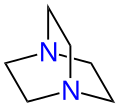Top Qs
Timeline
Chat
Perspective
DABCO
Chemical compound From Wikipedia, the free encyclopedia
Remove ads
DABCO (1,4-diazabicyclo[2.2.2]octane), also known as triethylenediamine or TEDA, is a bicyclic organic compound with the formula N2(C2H4)3. This colorless solid is a highly nucleophilic tertiary amine base, which is used as a catalyst and reagent in polymerization and organic synthesis.[3]
It is similar in structure to quinuclidine, but the latter has one of the nitrogen atoms replaced by a carbon atom. Regarding their structures, both DABCO and quinuclidine are unusual in that the methylene hydrogen atoms are eclipsed within each of the three ethylene linkages. Furthermore, the diazacyclohexane rings, of which there are three, adopt the boat conformations, not the usual chair conformations.
Remove ads
Reactions
Summarize
Perspective
The pKa of [HDABCO]+ (the protonated derivative) is 8.8, which is almost the same as ordinary alkylamines. The nucleophilicity of the amine is high because the amine centers are unhindered. It is sufficiently basic to promote a variety of coupling reactions.
Catalyst
DABCO is used as a nucleophilic catalyst for:
- formation of polyurethane from alcohol and isocyanate functionalized monomers and pre-polymers.[4]
- Baylis–Hillman reactions of aldehydes and unsaturated ketones and aldehydes.[5]
Lewis base

The reagent Selectfluor is derived by alkylation of DABCO with dichloromethane following by treatment with fluorine. A colourless salt that tolerates air, Selectfluor has been commercialized for use for electrophilic fluorination.[6]
As an unhindered amine, it is a strong ligand and Lewis base. It forms a crystalline 2:1 adduct with hydrogen peroxide[7] and sulfur dioxide.[8]
Quencher of singlet oxygen
DABCO and related amines are quenchers of singlet oxygen and effective antioxidants,[9] and can be used to improve the lifetime of dyes. This makes DABCO useful in dye lasers and in mounting samples for fluorescence microscopy (when used with glycerol and PBS).[10] DABCO can also be used to demethylate quaternary ammonium salts by heating in dimethylformamide (DMF).[11]
Remove ads
Production
It is produced by thermal reactions of compounds of the type H2NCH2CH2X (X = OH, NH2, or NHR) in the presence of zeolitic catalysts. An idealized conversion is shown for the conversion from ethanolamine:[12]
- 3 H2NCH2CH2OH → N(CH2CH2)3N + NH3 + 3 H2O
Uses
In chemical and biological defense, activated carbon is impregnated with DABCO for use in filters for masks, collective protection systems, and the like.[13]
References
Further reading
Wikiwand - on
Seamless Wikipedia browsing. On steroids.
Remove ads







